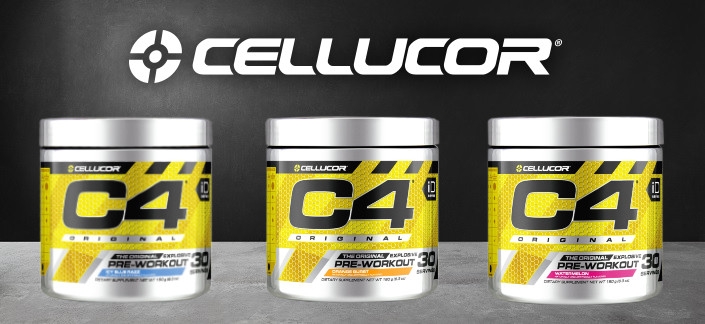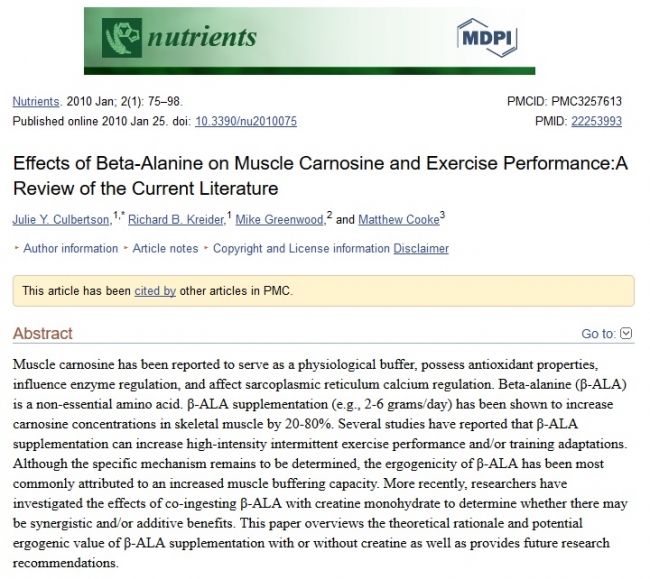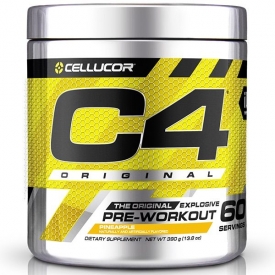C4 Pre-Workout Review

The original Cellucor C4 Pre-Workout has been a top seller in Australia and abroad for many consecutive years. With world-wide popularity like this, fans regard this product as powdered gold. However, there is always a fringe group of cynics who conclude that pre-workouts are nothing more than flavoured caffeine.
Where do you sit on this one?
Could we get just the same epic workouts from the caffeine equivalent in coffee or espresso?
Let’s take a quick look each and every ingredient in C4 Original, without getting so deep into the science that your eyelids get heavy.
Beta-Alanine
Beta-Alanine is the main ingredient in C4, making up 26.7% of the weight of the powder. This amino acid is a common ingredient in pre-workouts and can sometimes trigger an infamous tingling sensation in the skin.
Do the tingles necessarily mean it boosts performance or recovery though?
After all, rubbing up against a stinging nettle bush can also cause a tingling sensation ... and then some (not recommended).
Fortunately, the research is quite clear on beta-alanine. Taking anywhere between 2 to 6 grams of beta-alanine daily, causes muscle Carnosine level to dramatically increase, somewhere in the range of 20 to 80% (depending on the person).
And a muscle carnosine boost is exactly what we want to achieve with beta-alanine supplementation.
With regards to performance enhancement, most research points towards a dosage range of 4-6 grams daily (every day, training or rest day).
Carnosine is a muscle-specific dipeptide that has antioxidant and acid buffering roles.
Carnosine is made-up of 2 amino acids (dipeptide), which are beta-alanine and histidine. The amount of histidine in our body doesn’t typically limit Carnosine production, but the amount of beta-alanine does.
Expect to take around 180 grams of beta-alanine in order to get your muscle carnosine levels elevated. At 4 grams of supplemented beta-alanine daily (every day) this will take about 6 weeks.
The question remains, however: does a higher muscle Carnosine level actually leaf to enhanced performance or exercise adaptation?
We're not just boosting muscle carnosine levels for the heck of it, right?
So far the research is saying yes. There are benefits, but it all depends on the type of exercise you engage in.
Bouts of high-intensity exercise that last between 1 to 4 minutes are demonstrating decent results (1). This could be high repetition weight lifting, circuit training, running, rowing, swimming, and more.
When supplementing beta-alanine for these types of exercises, expect to see benefits that include:
- Improved Strength (2)
- Reduced Neuromuscular Fatigue
- Enhanced Tactical Performance (3)

So why doesn’t beta-alanine benefit exercises lasting less than 1 minute?
Maybe it does and we just don't know it yet. However, for now it is best to assume not.
It all comes down to the role Carnosine plays in the muscle cell. Remember, Carnosine is an acid buffer. We don’t generate an appreciable amount of lactic acid in the muscle for exercises that last less than 1 minute. For Carnosine to enhance performance, it seems that we need to be generating lactic acid.
So there it is in a nutshell. Beta-Alanine boosts muscle Carnosine levels, which is beneficial for exercises lasting around 1 to 4 minutes. This benefit is believed to be due to the buffering role of Carnosine on lactic acid.
Each scoop of Cellucor C4 contains 1.6 grams of beta-alanine. To reach the lower limit of therapeutic benefit for beta-alanine, you will need to top up each dose with another 2.4 grams, which is slightly more than half a teaspoon of pure beta-alanine powder.
If your caffeine tolerance is high and you are double scooping C4, as many are, your beta-alanine intake will only need a slight increase to be optimised.
Creatine is one of those rare sports nutrition nutrients that is backed by decades of research. We eat creatine through food at a quantity of about 1 gram per day (except for vegan and vegetarian diets). Our body also produces it at around 1 gram daily (4).
The benefits of creatine monohydrate are quite clear. It boosts strength and power in exercises that last up to 3 minutes (5). It also reduces recovery time between sets (6).
Don’t get me wrong. 99% of the research on creatine is on the creatine monohydrate form. And though creatine ethyl ester is not necessarily a good option, what about creatine nitrate (7)?
A 28 day study undertaken back in 2014 assessed the safety of both 1g and 2g doses of creatine nitrate in young healthy women and men. The researchers found no adverse effects, with all blood safety markers remaining within the normal range (8).
So it’s safe ...
But does it work?
A study in 2016 took the dosage up to 3 grams daily. The researchers showed that not only was creatine nitrate safe, but offered similar benefits to creatine monohydrate (9).
Each serve of Cellucor C4 contains 1 gram of creatine nitrate. This should be enough to experience some of the benefits of this nutrient. Though if you are a double-scooper (watch out for the caffeine), the 2 grams delivered is much more ideal.

Creatine Nitrate is a 2 for 1 nutrient. You get creatine. And you also get a dose of nitrates, which are found in beetroot. Nitrates have a separate set benefits of benefits to creatine and are discussed under Arginine Alpha Ketoglutarate further down the page.
Other uses for creatine are yet to be investigated in more depth. However, early research indicates that it can benefit depression (not manic depression), and even boost intelligence and working memory (10,11).
So there we are; more than 2 reasons why C4 is still occupying the shelves of Australia's Health Food Stores, Supps Stores and Gyms.
Arginine Alpha Ketoglutarate
You've no doubt you’ve heard of Arginine before. But what on earth is Alpha Ketoglutarate (AKG)?
Again, this is a combination ingredient like creatine nitrate.
AKG is a part of an important energy cycle in our body called the Citric Acid Cycle or Krebs Cycle. This energy cycle is a crucial mid-point in the production of cellular energy (ATP).
Alpha Ketoglutarate is believed to stimulate protein synthesis and slow down catabolic pathways (12). This way, it would have a muscle preservation effect.
As AKG is a part of the energy cycle, it may also be useful for improving stamina and endurance, though this is more of a theoretical idea at this stage.
Arginine has long been touted as a wonder nutrient to assist with Nitric Oxide (NO) production. NO is a gas produced within the blood vessel, which opens them up and promotes circulation.

It has long been contended that arginine boosts NO synthesis, increases circulation to muscles and therefore the delivery of nutrients needed to maintain high intensity exercise, such as oxygen, glucose and amino acids.
However, the research is still inconclusive at this stage regarding the arginine and arginine AKG effect on Nitric Oxide. In fact, clinical researchers have taken the dosage up to 12 grams daily to try and elicit a response (13).
What we do know is that arginine can increase growth hormone release from the pituitary gland and it can improve time to exhaustion in wrestlers (14,15).
That’s something, right?
Despite some disappointing clinical trial results, Arginine AKG may still offer an ergogenic effect via some other mechanism of action, boost GH levels and enhance overall anabolism.

The “nitrate” portion of creatine nitrate has in fact been shown to have a positive effect on Nitric Oxide and also to improve exercise performance. Nitrates are actually converted to Nitric Oxide in the mouth, by an enzyme called Nitrate Reductase (16,17)!
Other Ingredients
Cellucor C4 Original also contains B Vitamins, which support ATP production, and Vitamin C, which helps keep cortisol levels down during exercise.
With 150mg of Caffeine in each scoop, C4 Pre-Workout is middle of the road in terms of stimulants. Veteran pre-workout users might need a bit more of a kick. Though for weekend gym battlers and occasional users, this will probably be right on the money.
N-Acetyl L-Tyrosine is an acetylated form of tyrosine that passes into the brain. Tyrosine may help to improve mood and motivation by supporting the synthesis of neurotransmitters such as dopamine, noradrenaline and adrenaline. The L-Dopa naturally found in Mucuna pruriens also assists with this process.
Finally, Theacrine is also a dopaminergic nutrient. Its effects may in fact be enhanced by caffeine, giving the 2 nutrients a synergistic relationship. Dopamine is a part of the reward pathway in the brain, and is considered a feel-good neurotransmitter.
C4 Ultimate vs C4 Original
C4 Ultimate is a super-charged version of C4 Pre-Workout Original. It contains an extra 500mg of creatine nitrate per serve, 1.5g of Inositol-Stabilised Arginine Silicate on top of 1g of Arginine AKG. This Inositol-Stabilised form of Arginine Silicate is producing some great ergogenic results.
Add in a whopping 6 grams of Citrulline Malate, 1g Taurine, 1.5g of the wondrous Trimethylglycine (Betaine) and 300mg caffeine and you’ve got a pre-workout more appropriate for the long time pre user or a 100kg+ individual.
C4 Ripped vs C4 Original
With the same caffeine content between the 2 products (150mg/serve), C4 ripped offers a fat-burning focus, including the ingredients L-Carnitine Tartrate, Green Coffee, Cayenne and Coleus.
C4 Ripped still has the same Explosive Energy Blend to boost focus, mood and stamina, and packs the same dose of Beta-Alanine and Arginine AKG as its original counterpart.
C4 Extreme Energy vs C4 Original
C4 Extreme Energy contains double the caffeine (300mg/serve) and twice the beta-alanine (3.2g/serve) than C4 Original. C4 Extreme Energy also contains herbs for extra mental energy, including Rauwolfia vomitoria and Toothed Clubmoss.
Conclusion
C4 Original is a superb option for anyone wanting an energy boost and some natural performance enhancement. If your caffeine tolerance is high, you might prefer to double scoop or use C4 Ultimate or C4 Ripped.
Cellucor have done a fantastic job with the flavours in the original version of C4, even though pre-workout flavours are usually palatable. What’s the best flavour? We liked Blue Raspberry, Pink Lemonade and Strawberry Margarita the best. But that’s just us. We’ve chugged down a lot of pre-workouts over the years and do tend to go for some of the more unique flavours.
There are 11 flavours to choose from, so flavour-fatigue is not likely to come knocking on your door any time soon. And with this blend of stimulants, cognitive enhancers and ATP boosters, exercise-induced fatigue may also take some time to develop.
Train Hard.
References
- Hobson RM et al. Effects of B-Alanine Supplementation in Exercise Performance: a meta-analysis. Amino Acids 2012 Vol 43;1 p.25-37
- Trexler E T., et al. International society of sports nutrition position stand: Beta-Alanine. Journal of the International Society of Sports Nutrition. 2015
- Mate-Munoz et al. Effects of B-alanine supplementation during a 5-week strength training program: a randomized, controlled study. Journal of the International Society of Sports Nutrition. 2018 Vol 15;19
- Persky A and Brazeau G. Clinical pharmacology of the dietary supplement creatine monohydrate. Pharmacology Reviews. 2001 Vol 53 p.161-176
- Lanhers C et al. Creatine Supplementation and Upper Limb Strength Performance: A Systematic Review and Meta-Analysis. Sports Medicine. 2017 Vol 47 p.163-173
- Cooper R et al. Creatine supplementation with specific view to exercise/sports performance: an update. Journal of the International Society of Sports Nutrition. 2012 Vol 9;33
- Spillane M et al. The effects of creatine ethyl ester supplementation combined with heavy resistance training on body composition, muscle performance, and serum and muscle creatine levels. Journal of the International Society of Sports Nutrition. 2009
- Joy JM et al. 28 days of creatine nitrate supplementation is apparently safe in healthy individuals. Journal of the International Society of Sports Nutrition. 2014 Vol 11;60
- Galvan E et al. Acute and chronic safety and efficacy of dose dependent creatine nitrate supplementation and exercise performance. Journal of the International Society of Sports Nutrition. 2016 Vol 13;12
- Rae C et al. Oral creatine monohydrate supplementation improves brain performance: a double-blind, placebo-controlled, cross-over trial. Proceedings. Biological Sciences. 2003 Vol 270;1529 p.2147-2150
- Roitman S et l. Creatine monohydrate in resistant depression: a preliminary study. Bipolar Disorders. 2007 Vol 9;7 p.754-758
- Wu N et al. Alpha-Ketoglutarate: Physiological Functions and Applications. Biomolecules and Therapeutics. 2016 Vol 24;1 p.1-8
- Willoughby DS et al. Effects of 7 days of arginine-alpha-ketoglutarate supplementation on blood flow, plasma L-arginine, nitric oxide metabolites, and asymmetric dimethyl arginine after resistance exercise. International Journal of Sports Nutrition and Exercise Metabolism. 2011 Vol 21;4 p.291-299
- Besset A et al. Increase in sleep related GH and Prl secretion after chronic arginine aspartate administration in man. Clinical and Translational Endocrinology. 1982 Vol 99 p.18-23
- Yavuz HU et al. PRE-EXERCISE ARGININE SUPPLEMENTATION INCREASES TIME TO EXHAUSTION IN ELITE MALE WRESTLERS. Biology of Sport 2014 Vol 31;3 p.187-191
- Lidder Satnam and Webb AJ. Vascular effects of dietary nitrate (as found in green leafy vegetables and beetroot) via the nitrate-nitrite-nitric oxide pathway. British Journal of Clinical Pharmacology. 2013 Vol 75;3 p.677-696
- Qu XM et al. From Nitrate to Nitric Oxide. The Role of Salivary Glands and Oral Bacteria. Journal of Dental Research. 2016
Header Image Background Designed by RawPixel.com, Courtesy of FreePik.











